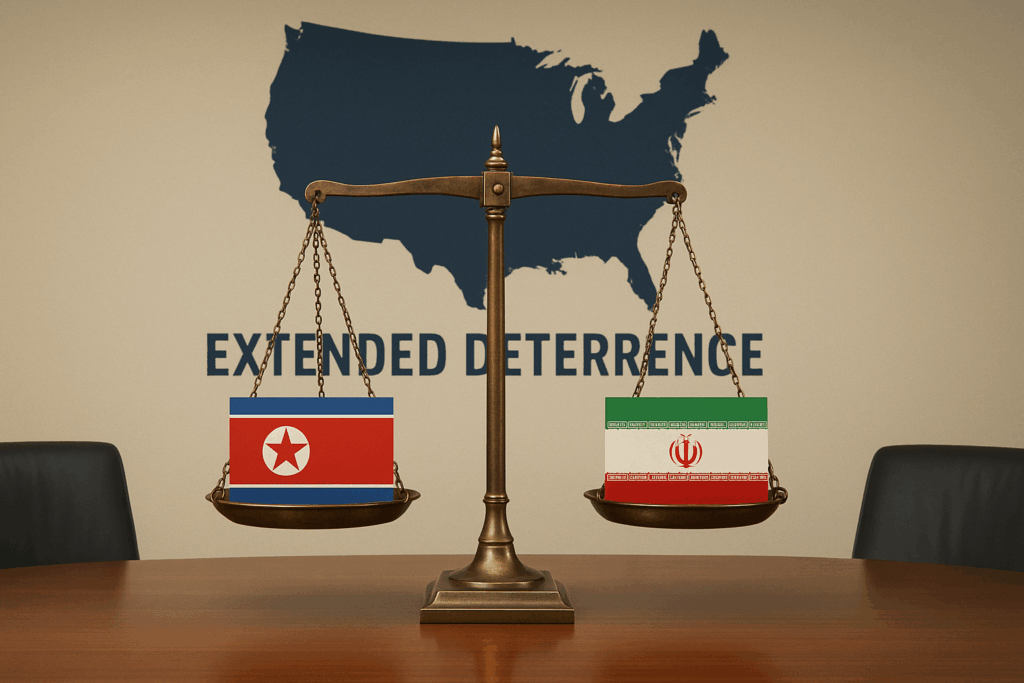On June 22, the United States struck multiple Iranian nuclear sites, marking a tipping point in its deterrence of the Islamic Republic’s nuclear ambitions. It was no longer enough to institute unilateral or multilateral sanctions against the regime, carry out strikes against its proxies, or support Israel’s own military action; direct American military power was needed against Iran itself. After all, Iran was dangerously close to producing a nuclear weapon.
The near completion of Iran’s nuclear weapon brings to mind another rogue state’s activities. In 2006, after years of global efforts aimed at preventing the Kim regime from obtaining nuclear weapons, North Korea (DPRK) conducted its first nuclear test. Today, the DPRK has an estimated 50 nuclear weapons and fissile material for 6 or 7 more.
An in-depth comparison of US engagement with Iran and the DPRK’s nuclear programs requires a much longer paper. However, a brief comparative analysis of American extended deterrence of these adversaries is possible. Applying national interests, objectives, and activities, a methodology employed by decision analysis experts, such as Allison Astorino-Courtois, yields interesting results.
Globally, the United States has an enduring interest in safeguarding its national security and sovereignty. Underneath this enduring interest, it has a core objective of defending allies and partners, including through credible extended deterrence (e.g., preventing conventional and/or nuclear attacks by the DPRK, China, Russia, and Iran). Other major American objectives include safeguarding the free flow of commerce, countering transnational threats, preventing regional domination or aggression, and advancing nonproliferation.
The United States advances extended deterrence through a range of activities, including the presence of its own military assets and security cooperation with allies and partners. In the Indo-Pacific, this includes mutual defense treaties with Australia, South Korea, Japan, and the Philippines; arms sales to Taiwan; and military exercises with allies.
More recently, the Trump administration emphasized increased allied defense spending to support “burden-sharing.” Given the limitations of the American industrial base, this is necessary even as the US maintains efforts to prevent Chinese and North Korean aggression.
Extended deterrence against North Korea is successful insofar as it keeps the North from invading the South or launching nuclear strikes on the US or its Indo-Pacific allies. However, this extended deterrence is increasingly complicated by Chinese and Russian protection of the DPRK through mutual defense treaties.
This lends greater urgency to the American call for allies to increase defense spending, as there is a real risk of simultaneous conflict with China and North Korea, a scenario requiring substantial military assets in the region. Fulfilling the objective of regional extended deterrence also requires containing aggression from adversaries and bolstering security cooperation with allies and partners.
The United States supports extended deterrence in the Middle East by deploying its military forces and cooperating with allies and partners. However, regional extended deterrence often manifests as kinetic operations against adversaries, whether through security assistance or direct attacks. Thus, in the Middle East, extended deterrence also means advancing the goals of proliferation and degrading terror groups who threaten allies.
Unlike in the Indo-Pacific, where the United States prefers to contain aggression and expansion from nuclear-armed adversaries without firing a shot, in the Middle East, it will employ kinetic means to fulfill its objectives. For decades, the United States deterred Iran through sanctions, negotiations, and the threat of military action. It was when President Trump believed Iran’s uranium enrichment program was “at its highest levels and…unprecedented for a state without nuclear weapons” that the American strategy shifted to kinetic attack.
The deep rifts in Middle East politics complicates the activities needed to maintain extended deterrence in the region. Furthering security cooperation between Israel and the Gulf states, for example, is challenging given the history of the Arab-Israeli conflict, including Israel’s recent strike against Hamas in Qatar.
Deterrence must also account for energy security concerns, given Iran’s attempts to control the Straits of Hormuz. It is also unclear how far back American strikes set Iran’s nuclear program. If Iran’s proxy network persists, they can commit further violence against the United States, its allies, and partners through attacks on military, commercial, and civilian targets.
None of these challenges are simple or pretty. American extended deterrence in the coming years may look very different as the nation shifts focus to the homeland and the Indo-Pacific. It remains to be seen how this imperative is realized in the forthcoming National Defense Strategy. Some critics note that, in practice, the United States remains heavily focused on the Middle East and Europe. Much of the ability to deter Iran and North Korea will be determined by these larger strategic shifts.
As American decision-makers face questions about effectively deploying American power across the globe, analyzing national interests, objectives, and activities can provide a helpful framework. Assessing the requirements needed to advance larger regional goals brings trade-offs into focus, better preparing the American warfighter for multiple threat scenarios. In short, this approach can yield meaningful results for those in the decision-making chair at critical moments when faced with complex problems, including maintaining credible extended deterrence.
Nathan Heath is an analyst at NSI. Views expressed are his own.

